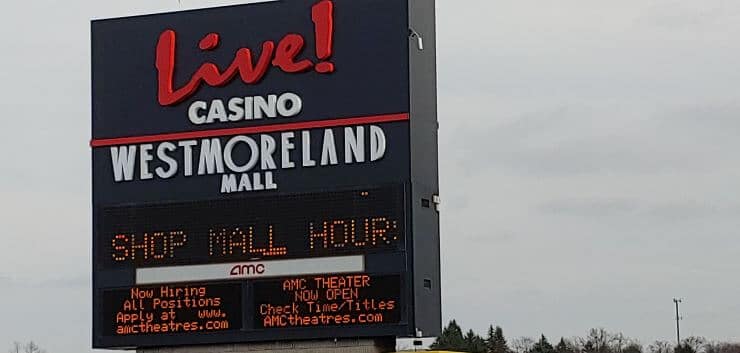The first hint of how much revenue a Pennsylvania mini-casino can make from gamblers who like playing close to home will come next week — but only a hint.
That’s because monthly revenue figures for November to be released by the Pennsylvania Gaming Control Board will contain the first financial information about the new Live! Pittsburgh casino, but for just a week of operation.
The Cordish Companies-owned venue near Greensburg, about 35 miles east of Pittsburgh, opened Nov. 24 with 750 slot machines and 30 table games. It’s looking to draw customers from Westmoreland and nearby counties while competing with the Rivers Casino in Pittsburgh and Meadows Racetrack & Casino in adjacent Washington County, which each have about three times as many slots and tables.
The mini-casino opens amid great uncertainty in the gaming industry from the COVID-19 pandemic, but Cordish officials are counting on how much area residents are starved for entertainment. They also profess confidence that gamblers will feel reassured by all of the advanced health and safety precautions they’ve put in place in the remodeled department store space at Westmoreland Mall.
But at the same time, they’re opening in a western Pennsylvania environment where the region’s casinos have suffered more year-over-year revenue loss since reopening in June than those elsewhere in the state. Now, with a new competitor in the market, there’s a chance their revenue could drop even more.
Retail gaming down as online betting surges
While the March-June shutdown of Pennsylvania’s first 12 casinos was costly for both the operators and state, which collects some 40% of the land-based casinos’ revenue, the state’s gaming industry is now garnering more revenue overall than ever before.
That’s misleading, however, in terms of how the traditional slots and table games play inside casinos is faring.
October set a revenue record for any month in the 14-year history of Pennsylvania casinos, with $320.2 million netted from all sources. The new high could be explained by the records of $59.8 million in Pennsylvania online casino revenue and $36.8 million in sports betting revenue.
With coronavirus concerns knocking out casino amenities and reducing visitation, October slots revenue of $154.7 million at the 12 properties was off 17.2% from October 2019 and table games revenue of $63.3 million was down 13.4%. Somewhat similar declines took place in August and September, even as overall revenue improved from the year before, again due to online play.
The table below shows how the change from a year ago has generally been worse for the four western-situated casinos — the Rivers, Meadows, Lady Luck Nemacolin, and Presque Isle Downs & Casino — than is the case statewide.
| October 2019-to-2020 revenue change | Rivers | Meadows | Presque Isle | Lady Luck | Statewide |
|---|---|---|---|---|---|
| Slots | -28.2% | -15.4% | -27.6% | -31.9% | -17.2% |
| Table games | -8% | -16.1% | +7.9% | -36.9% | -13.4% |
One factor that could be at work is the population of western Pennsylvania is older than in the east. Industry officials nationwide have reported that patronage by older casino customers has dipped more than that of other guests due to their concerns about COVID-19.
That’s a demographic challenge also faced by Live! Pittsburgh, as Westmoreland County’s percentage of residents 65 and older is 23.3%, compared to a statewide average of 18.7%.
Mini-casino General Manager Sean Sullivan, however, has exuded plenty of optimism about the property’s prospects.
Could saturation/cannibalization become an issue?
Industry veteran Sullivan has helped run many casinos, including the Meadows from 2009-2018, so he knows the region well. And he believes the Live! property has a niche that will attract plenty of business.
“I love the energy” of the place, he said on opening day. “When places are smaller and intimate, the energy is contagious. [COVID’s impact] really hurts the bigger places, like the Rivers and Meadows, that struggle because it takes a whole bunch of people to create that energy.”
He acknowledged little concern, either, about the possibility of oversaturation of the regional market with the mini-casino’s arrival.
“There’s always that conversation, no matter what the state or jurisdiction, of when is too much too much,” Sullivan said, but he added that people from Westmoreland County and nearby will appreciate having “a favorite hometown casino. I’ve had people saying, ‘Thank you for being here — I don’t have to drive an hour.’”
He believes all of the state’s western casinos will survive just fine with the addition of a new one, even if there’s some new initial impact — or cannibalization — on a small scale.
“Current operators are always threatened by new operators,” Sullivan said. “We will put a hurt on Rivers and the Meadows, but not a huge one. We’ll grab a bit of their business — a lot of it is about proximity — and this property will compete handsomely.”
He also acknowledged he hasn’t been following the revenue trends of the region’s other casinos closely, but he believes Live! will earn much more revenue than the state’s smallest volume generator, Lady Luck in adjacent Fayette County.
Casino expansion might add $500 million a year
Lady Luck is in the state’s “resort casino” category with its own restrictions on what it can offer, leaving it with 600 slot machines normally — although that number has been reduced to 322 by the state’s COVID-related capacity restrictions. The property has 27 gaming tables.
That venue attached to the Nemacolin Woodlands resort generated about $33 million in slots and table revenue in 2019, although it won’t match that in 2020 due to the coronavirus. In its rural location far from any population center, it is by far the smallest revenue generator among Pennsylvania casinos.
Sullivan said he believes Live! will surpass Lady Luck and come closer to competing with Presque Isle Downs. They share locations in busy commercial corridors close to mid-sized cities. Pre-COVID in 2019, Presque Isle Downs had 1,525 slot machines and 41 tables and garnered more than $129 million in revenue. The Erie County venue has employed only 1,065 slots in recent months, and its slots revenue has been down by more than a fourth.
It might be a stretch, however, for Live! to match Presque Isle, considering how many fewer slots and tables it can have.
Average revenue per slot and table has generally been lower in the four western casinos than statewide. In the COVID era, slots are earning about $200 a day per machine or slightly more in the region — well below the $299 average statewide. Table games vary more widely, with Rivers generating far more from them than the region’s other casinos — about $55,000 per position monthly — though really just the equivalent of the statewide norm.
If Live! were just to match the average of what other casinos on its side of the state have been doing recently, it could conceivably generate $54 million in annual slots revenue and $9 million in table revenue, based on its 750 machines and 30 games. That’s without accounting, however, for any reduction that may take place in recent averages due to additional competition in the market.
But if those numbers hold true for the first of five planned mini-casinos, the mall gaming site on U.S. Route 30 could generate more than $60 million in annual gaming revenue to join iGaming in compensating for the first dozen casinos’ decline in slots and table revenue in the COVID era.
With two more mini-casinos expected to open next year and two more subsequently, that could mean a potential $300 million or more collectively from mini-casino revenue. Add in $200 million or more in possible revenue from the large Live! Philadelphia casino opening in early 2021, and at some point the slots and table games revenue from Pennsylvania’s brick-and-mortar casinos could approach $4 billion a year compared to the $3.26 billion of 2019. Again, that’s not accounting for the unknown amount of cannibalization of existing revenue that could take place from the expansion.
A lot will also depend on the continued effects of — or rebound from — COVID. And the first small hint of what the future may hold will come in that November revenue report next week.






